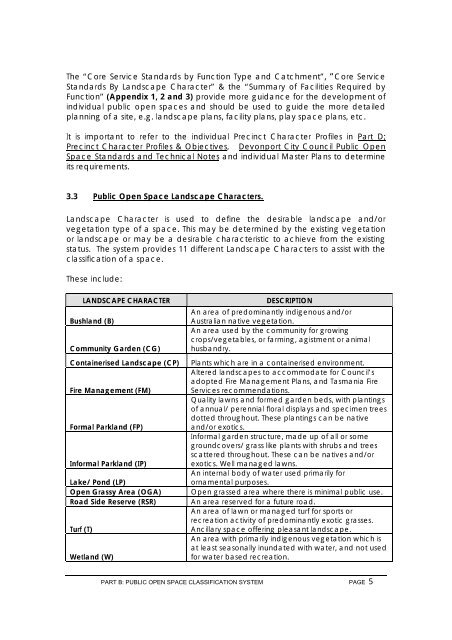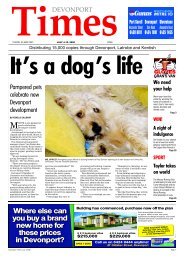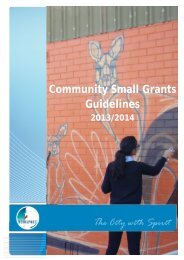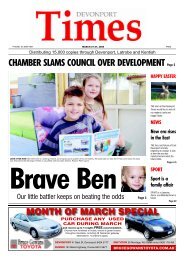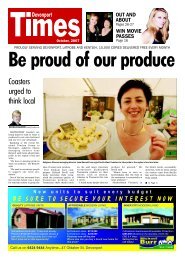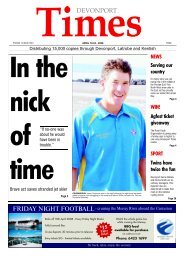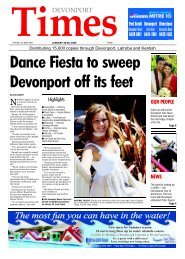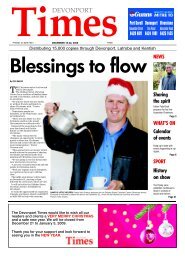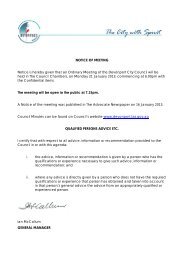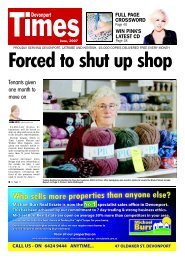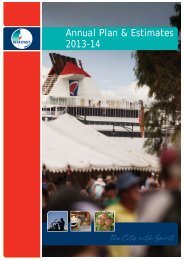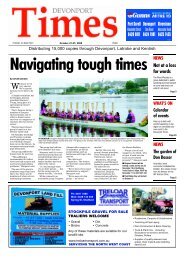Public Open Space Guidelines 2.17 Mb - Devonport City Council
Public Open Space Guidelines 2.17 Mb - Devonport City Council
Public Open Space Guidelines 2.17 Mb - Devonport City Council
Create successful ePaper yourself
Turn your PDF publications into a flip-book with our unique Google optimized e-Paper software.
The “Core Service Standards by Function Type and Catchment”, “Core ServiceStandards By Landscape Character” & the “Summary of Facilities Required byFunction” (Appendix 1, 2 and 3) provide more guidance for the development ofindividual public open spaces and should be used to guide the more detailedplanning of a site, e.g. landscape plans, facility plans, play space plans, etc.It is important to refer to the individual Precinct Character Profiles in Part D;Precinct Character Profiles & Objectives, <strong>Devonport</strong> <strong>City</strong> <strong>Council</strong> <strong>Public</strong> <strong>Open</strong><strong>Space</strong> Standards and Technical Notes and individual Master Plans to determineits requirements.3.3 <strong>Public</strong> <strong>Open</strong> <strong>Space</strong> Landscape Characters.Landscape Character is used to define the desirable landscape and/orvegetation type of a space. This may be determined by the existing vegetationor landscape or may be a desirable characteristic to achieve from the existingstatus. The system provides 11 different Landscape Characters to assist with theclassification of a space.These include:LANDSCAPE CHARACTERBushland (B)Community Garden (CG)Containerised Landscape (CP)Fire Management (FM)Formal Parkland (FP)Informal Parkland (IP)Lake/ Pond (LP)<strong>Open</strong> Grassy Area (OGA)Road Side Reserve (RSR)Turf (T)Wetland (W)DESCRIPTIONAn area of predominantly indigenous and/orAustralian native vegetation.An area used by the community for growingcrops/vegetables, or farming, agistment or animalhusbandry.Plants which are in a containerised environment.Altered landscapes to accommodate for <strong>Council</strong>’sadopted Fire Management Plans, and Tasmania FireServices recommendations.Quality lawns and formed garden beds, with plantingsof annual/ perennial floral displays and specimen treesdotted throughout. These plantings can be nativeand/or exotics.Informal garden structure, made up of all or somegroundcovers/ grass like plants with shrubs and treesscattered throughout. These can be natives and/orexotics. Well managed lawns.An internal body of water used primarily forornamental purposes.<strong>Open</strong> grassed area where there is minimal public use.An area reserved for a future road.An area of lawn or managed turf for sports orrecreation activity of predominantly exotic grasses.Ancillary space offering pleasant landscape.An area with primarily indigenous vegetation which isat least seasonally inundated with water, and not usedfor water based recreation.PART B: PUBLIC OPEN SPACE CLASSIFICATION SYSTEM PAGE 5


